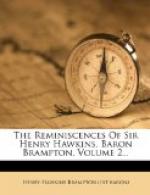Imagine a man forgetting he had L3,000 a year and an estate in England worth L30,000, and earning his bread in a slaughter-house and in the Bush, borrowing money from a poor woman and running away with it.
But now another singular thing stamps this fraudulent impostor who makes so many believe in him. He, alleged by his supporters to be Sir Roger Tichborne, recollected all about a place that he had never been to; people he had never heard of, far less seen; events that he could not know and which never happened to him, but did happen to Arthur Orton. He knew Wapping well—every inch of it; Old Charles Orton, the father of Arthur; Charles Orton the brother, the sisters, the people who kept this shop and that; so that when on his return to England he went to the Wapping seat of his ancestors instead of Ashford, he asked all about them, and reminded them so faithfully of the little events of Arthur’s boyhood, and resembled that person so much in the face, that they said, “Why, you are Arthur Orton yourself!” True, he paid some of them to swear he was not, but the impression remained.
Mr. Hawkins told the jury how he picked up his second-hand knowledge of the things he spoke about concerning the Tichbornes, for it was necessary to be able to answer a good many questions wherever he went, especially when he went into the witness-box.
There was an old black servant, quite black, who had been a valet in the Tichborne family. His name was Bogle; and the Claimant was told by the poor old dowager that if he could meet with him, Bogle could tell him a good many things about himself.
Bogle was an excellent diplomatist, and no sooner heard from Lady Tichborne that her son Roger was in Australia than the two began to look for one another, the one as black inside as the other was out. Bogle announced that he was the man before he saw him, on the mother’s recommendation, and became and was to the end one of his principal supporters—so much so that “Old Bogle” spread the Claimant’s knowledge of the Tichbornes abroad, and, like everybody else, believed in him because he knew so much which he could not have known unless he had been the veritable Roger, all which Bogle had told him.
But in the interests of justice “Old Bogle” and Mr. Hawkins became acquainted, much to the advantage of the latter, as he happened to meet Bogle in the witness-box, a place where the counsel unravelled the trickster’s most subtle of designs. The advocate liked “Old Bogle,” as he called him, because, said he, Bogle, having white hair, was so like a Malacca cane with a silver knob, white at the top and black below.
Bogle had sworn that Roger had no tattoo marks when he left England. In point of fact he had, and Bogle had to fit them to the Claimant, who had had tattoo marks of a very different kind from Roger’s. The Claimant had removed his, and therefore was presented to the court without any.




